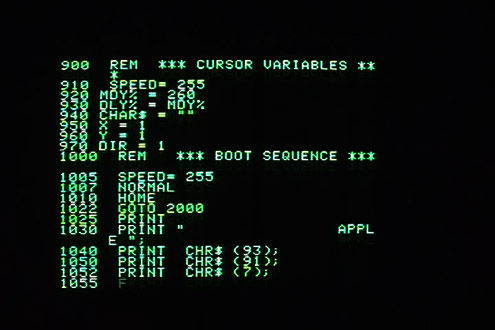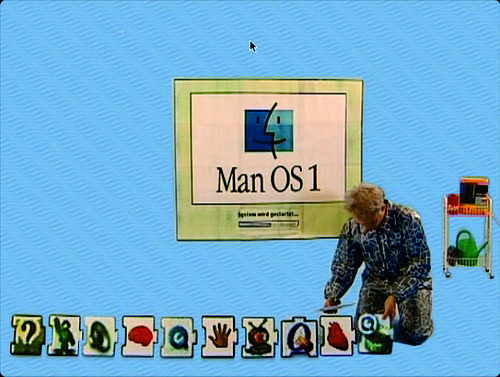
Here are some quotes from German sociologist and media researcher Volker Grassmuck:
“Animation’ is the bestowment of a soul onto technical objects, a secondary animism. For a specialist in psychological aspects of religion the underlying mechanism might be the same – a projection. But now the objects onto which supernatural qualities are projected are not natural any more, they are technical, man-made. They are media.”
(‘From Animism to Animation. Towards a Re-Enchantment of the World‘)
“Having passed through history from animism to animation (animateness of the first, and secondary animation of the second nature), the subject, in its quest for reunification, has returned into its self-made paradise. Flusser’s demand for thought, feeling and action in the ‘possibility’ category would thus mean getting involved with the computer. The machine, being called host and server, is only too ready to let us get involved. It is up to us to let ourselves be invited and served up by these machines, to get settled in them.”
(‘Computer Aided Nature in the Turing Galaxy. Life on stage of Computerspace‘)
Some nice video works that seem to literally take up that last advise…Stewart Smith, ‘Jed’s other poem (beautiful ground)’ (2005)
Stewart Smith programmed this entirely in Applesoft BASIC on a vintage 1979 Apple ][+ with 48K of RAM — a computer so old it has no hard drive, mouse up/down arrow keys, and only types in capitals. Code is Open Source and available on website. Cinematography by Jeff Bernier.” A nice detail of the story is that this was originally a fan vid (for the now disbanded Grandaddy – the song in the video is from their wonderful album ‘The Sophtware Slump’ (2000), that is sort of woven around the story of Jed, a forlorn humanoid robot made of junk parts who eventually dies, leaving behind a few mournful poems) but was eventually adopted as the “official” video for the song.
Michael Wesch, ‘web 2.0 … the machine is us/ing us (final version)’ (2007)
Michael Wesch is a cultural anthropologist and media ecologist exploring the impacts of new media on human interaction. He made this video with CamStudio for the screen captures and Sony Vegas for the panning/cropping/zooming animations. He considered releasing it as an “eternal beta” in true Web 2.0 style, but decided to let it stand as it is and start working on future projects (future videos apparently will address the last 30 seconds of this video – the “rethink …” part). This work is licensed under a Creative Commons Attribution-Noncommercial-Share Alike 3.0 License. HiRes versions are available for download.
Alan Becker, ‘Animator vs. Animation’ (2006)
“An animator faces his own animation in deadly combat. The battlefield? The Flash interface itself. A stick figure is created by an animator with the intent to torture. The stick figure drawn by the animator will be using everything he can find – the brush tool, the eraser tool – to get back at his tormentor. It’s resourcefulness versus power. Who will win? You can find out yourself.” It took Alan Becker several months to animate this piece. The sequal too him even longer!

Roland Seidel & Achim Stiermann, ‘MAN OS / extraordinateur’ (Installation, 450x450x300 cm , 2005). Video not available as yet.
See Robert Seidel’s website for an overview of this installation. “In Man OS 1 / extraordinateur the internal work processes of a computer are presented in real human form. The Processor is a person who carries out the commands of a user on a monitor. On a stage, whose backdrop is the surface of a screen, the person executes programs, manages the operating system and interacts with a mouse pointer. Added digitally during postproduction, the pointer symbolizes the user who remains invisible throughout the film. Digital processes and human behavior are propelled together and find a common denominator in their fallibility.After the computer has been started, an e-mail arrives from Hans Holbein the Younger. He invites the computer user to smarten up the figures in the painting entitled The Ambassadors, which has arrived with the e-mail, for their Internet appearance. For instance, using Photoshop, one of the two figure’s beards is shaven off. Along with the e-mail, a virus has infiltrated the system in the form of a “bug”, which in the course of events repeatedly sabotages the work processes which seemed to be running smoothly. The character Norton Disk Doctor examines the Processor and finally finds the virus. On the Internet the Processor encounters the characters H, T, M and L, who are responsible for the configuration of the page. Together they visit a ping-pong page, a film page and a few erotic pages. In an Internet shop the processor buys some new accessories, which are then added to into Holbein’s painting. In between, the user listens to music using Soundjam. During a game of PacMan, the Processor is knocked down by ghosts. While burning the new version of Holbein’s painting on a CD, the “Toaster” catches fire and SETI (“Search for Extraterrestrial Intelligence”) reveals that the figures in the painting are extraterrestrial. This is all too much for the Processor and the entire system crashes.”
Update 27.12.2008
I thought this one would fit here as well. It’s “Big Ideas (don’t get any)” by James Houston, one of the Radiohead “Nude” remix videos (see also previous post).